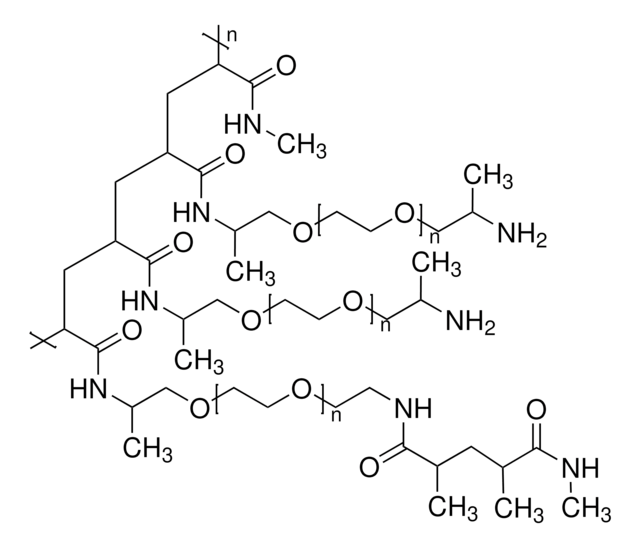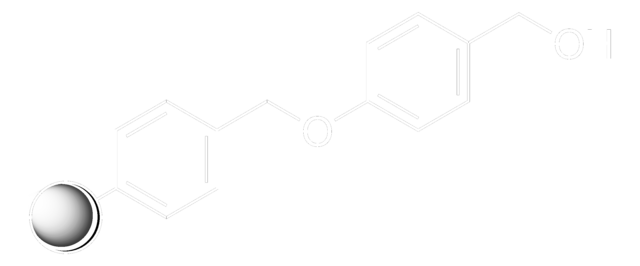8.55015
Amino PEGA resin
Novabiochem®
Sinónimos:
Amino PEGA resin
About This Item
Productos recomendados
Quality Level
product line
Novabiochem®
PEGA
form
beads
reaction suitability
reaction type: Fmoc solid-phase peptide synthesis
manufacturer/tradename
Novabiochem®
application(s)
peptide synthesis
functional group
amine
storage temp.
2-8°C
General description
Associated Protocols and Technical Articles
Protocols for Loading of Peptide Synthesis Resins Literature references
Literature references
[1] M. Meldal, et al. (1992) Tetrahedron Lett., 33, 3077.
[2] F. I. Auzanneau, et al. (1994) J. Peptide Sci., 1, 31.
[3] M. Meldal in ′Peptides 1992, Proc. 22nd European Peptide Symposium′, C. H. Schneider & A. N. Eberle (Eds), ESCOM, Leiden, 1993, pp.61.
[4] M. Meldal, et al. in ′Innovation & Perspectives in Solid Phase Synthesis, 3rd International Symposium′, R. Epton (Eds), Mayflower Worldwide, Birmingham, 1994, pp. 259.
[5] M. Meldal, et al. (1993) Int. J. Peptide Protein Res., 41, 250.
[6] M. Meldal, et al. (1994) J. Chem. Soc., Chem. Commun., 849.
[7] M. Meldal, et al. (1994) Proc. Natl. Acad. Sci. USA, 91, 3314.
[8] M. Renil, et al. (1998) J. Peptide Sci., 4, 195.
[9] J. C. Spetzler, et al. (1998) J. Peptide Sci., 4,128.
[10] M. Meldal, et al. (1998) J. Peptide Sci., 4 ,83.
[11] J. A. Camarero, et al. (1998) J. Peptide Res., 51, 303.
[12] J. A. Camarero, et al. (2000) Lett. Pept. Sci., 7,17.
[13] O. Melnyk, et al. (2001) J. Org. Chem., 66, 4153.
[14] J. Buchardt, et al. (2000) J. Comb. Chem., 2, 624.
[15] J. F. Tolberg, et al. (2002) J. Org. Chem., 67, 4143.
[16] J. Bondebjerg, et al. (2002) J. Am. Chem. Soc., 124, 11046.
[17] J. Tulla-Puche, et al. (2004) J. Org. Chem., 69, 4101.
[18] S. Aggarwal, et al. (2005) Biomaterials, 26, 6077.
Application
- Fluorescence-Based On-Resin Detection of Three Model Proteases: Discusses the use of Amino PEGA resin modified with backbone amide linker (BAL) for developing solid support-bound probes used in fluorescence-based assays. (Milicevic & Hlavác, 2021).
- Attachment of cyclodextrin acids to PEGA resin and study of binding with fluorescence microscopy: Investigates the attachment of cyclodextrin to amino PEGA resin and evaluates their binding interactions using fluorescence microscopy. (Langhorn et al., 2021).
Linkage
Analysis Note
Appearance of substance (visual): beads
Loading (determined from the substitution of the Fmoc-Leu loaded resin): 0.30 - 0.50 mmol/g
Swelling Volume (in DMF): lot specific result
Swelling Volume (in water): lot specific result
dry resin %: lot specific result
The resin is sold swollen in ethanol. 50 - 100 mesh
Legal Information
Storage Class
11 - Combustible Solids
wgk_germany
nwg
flash_point_f
Not applicable
flash_point_c
Not applicable
Certificados de análisis (COA)
Busque Certificados de análisis (COA) introduciendo el número de lote del producto. Los números de lote se encuentran en la etiqueta del producto después de las palabras «Lot» o «Batch»
¿Ya tiene este producto?
Encuentre la documentación para los productos que ha comprado recientemente en la Biblioteca de documentos.
Los clientes también vieron
Contenido relacionado
The Novabiochem® product line has one of the most extensive ranges of polymer-supports for solid phase peptide synthesis. They range from high-loaded, lows welling for the large-scale production of relatively short peptides to high-swelling, low-loaded for the synthesis of long or difficult sequences.
Nuestro equipo de científicos tiene experiencia en todas las áreas de investigación: Ciencias de la vida, Ciencia de los materiales, Síntesis química, Cromatografía, Analítica y muchas otras.
Póngase en contacto con el Servicio técnico









